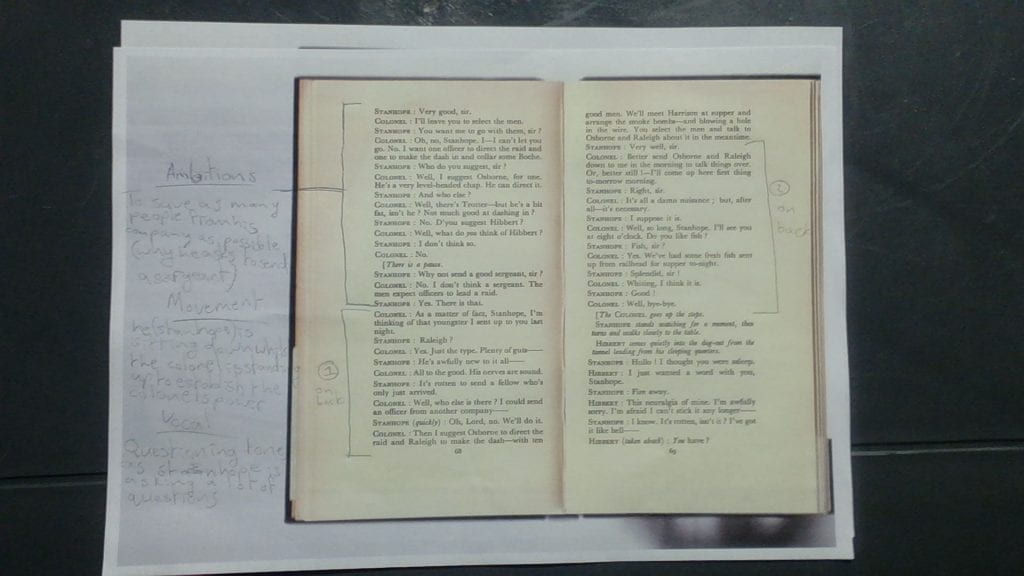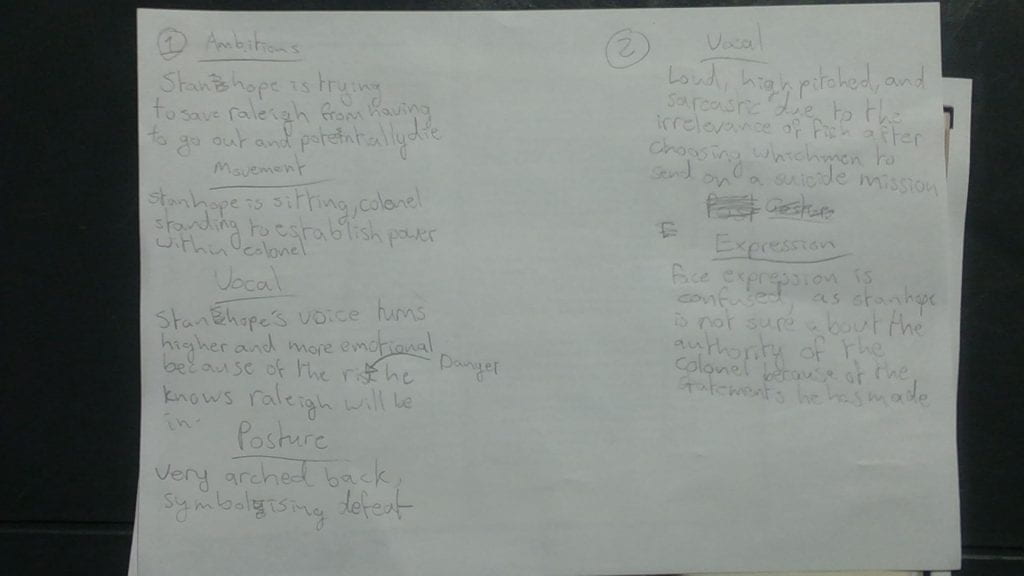The vision of the play was to show how relationships change in different situations. This was shown through long scenes between two characters that developed their relationships and the characters in them.
The play “A Journey’s End” is a piece centered around Stanhope, the captain of “C company” and his group, Raleigh (a new recruit that joined this specific company by choice), Osborne (an older man that has been in the war for a while), Mason (the company chef that is light-hearted and joyful), and Hibbert (a man that wants to leave the company at whatever cost – very anxious and fearful of death). We changed the play to be centered around the relationships between the characters, and the way that they change throughout the play. The way we did this is by keeping a lot of the two-person scenes in and leaving out a lot of scenes that focus on other things. This play’s theme was realism, because of the way that the characters and relationships between characters over time. The characters throughout the film change their ambitions and motives, and the opinion they have on the other characters.
Q1: Please discuss the movement techniques you selected and how you applied these to create your character.
As an actor playing the role of Stanhope, I had to consider this status as a captain. This informant my movement choices. In particular, I used posture – open body language, elongated my spine to give me height, and used upright, strong, and controlled energy. My head is lightly balanced on my spine.
When I say the line “Give me that letter!”, I shout it and stand tall and forward to show that I am the most dominant and move forward, grabbing Raleigh’s hand to take the letter that he wrote off him because I was worried about what he said about me (Stanhope) in the letter. Then after Raleigh says “Dennis-,” I shout in his face, “Don’t you ‘Dennis’ me! Stanhope’s my name!”. The audience would be surprised at the harshness of Stanhope as they had learned in the previous scene that Raleigh was like my brother throughout the late school. The symbolism of this is the effect that war has on people, the PTSD, and the post-trauma effects. In the next scene, Raleigh dies, and Stanhope doesn’t feel as if he treated Raleigh correctly in Raleigh’s time in the trench, because of this, the audience is left feeling worried about the outcome of the soldiers within the trench. As Stanhope is leaving the set for the final time (as the play is finishing after Raleigh dies), he looks back at Raleigh’s body as if he is saying goodbye to a friend for the last time.
Q2: Please discuss the vocal techniques you selected to create your character.
In the final part of the final scene of the play, when Raleigh is dying and officer Broughton runs in to inform Stanhope that he is needed outside, Stanhope goes to get a lamp and blanket for Raleigh as he says it is “frightfully dark and cold”. Stanhope comes back to find Raleigh lifeless on the floor, and says “Is that better Jimmy… Jimmy? Is that better?” and then proceeds to kneel beside Raleigh’s corpse. The tone that the line is delivered in is worry and caring, this is because Stanhope is concerned about Raleigh being able to make it home alive, therefore the line is delivered at a high pitch, signifying emotion and care. The pace of the line varies, as throughout the line, Stanhope realizes that Raleigh has died. The energy of the line is very low as Stanhope is feeling defeated and hopeless, as Broughton runs in to tell him that they (all of the men from Stanhope’s trench) are under fire and are dying. This line is in the 2nd circle of attention, it is just between Stanhope and Raleigh because of their relationship.

